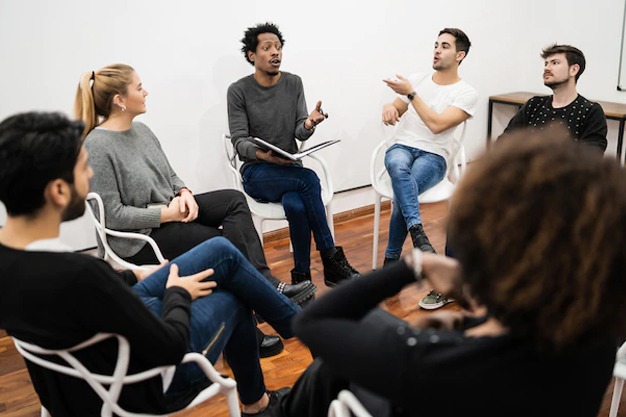July, 2024
A group discussion, often known as GD, is a discussion in which participants share ideas or debate over a particular topic. Every GD has a common theme and everyone in the group reflects their point of view based on that concept. In a GD, the group generally consists of seven or eight people and you'll meet with your group to discuss the common theme after finishing your individual assessment. This not only broadens your learning but also gives you the confidence to share new ideas in broader classroom conversations. But, public speaking, even in front of a small audience, can be terrifying for people for various reasons.
The fear of public speaking is a common phobia. It might range from mild jitters to crippling fear and panic. Many persons who suffer from this phobia avoid public speaking altogether or suffer through it with trembling hands and a quavering voice. Thats why it becomes important to tackle this widespread problem and you owe it to yourself to come up with some tactics and techniques for managing your nerves so that you can focus on giving effective pointers in a GD. Here are a few pointers to help you conquer your fear of speaking in front of a group:
1) Keep calm
Everyone experiences physiological reactions such as a racing heart or trembling hands. This is normal to an extent, so don't equate these sentiments with the fear of doing poorly or making a fool of yourself. Keeping calm and becoming comfortable with the information you've obtained are the best ways to overcome anxiety. For example, you might prepare a list of possible general pointers ahead of time. Alternatively, just before your turn to give comments, you might take knowledge from what others have said. Finally, you may rely on vocal patterns to guide you, such as beginning every introduction with I partially agree with you and wish to add...
2) Time your entry
When you find a strong point you want to put forth, you should smartly find a way into the ongoing discussion. Make sure, it's not too late into the discussion though. Your entry should be emphatic enough to get everyone attentive towards you. However, avoid screaming or rambling as it may go against you even if your points are valid. Assess the reactions of your peers to what you're speaking and treat that as feedback.
3) Focus on your body language
Positive body language conveys confidence and security in a group discussion. It shows enthusiastic participation and provide a positive first impression. Sitting up straight, making eye contact, and expressing your thoughts with measured gestures are all examples of positive gestures. Remember, non-verbal communication is as important as verbal communication. Positive body language aids in conflict resolution and hostility management. In a group conversation, your body language might reveal how energetic you are. However, please ensure that you don't go overboard with gestures as it could distract your peers and take away from what you're speaking.
Final Word
You'll communicate with your peers and put forth your thoughts with more clarity, if you treat the interaction as an opportunity to grow. You can think faster, communicate smarter, and become a more captivating, confident, connected spontaneous speaker by structuring your point of view before speaking. And as mentioned earlier, a little bit of nervousness before speaking in front of a group is just fine.
Also read: What are the Benefits of CBSE Education?
Back to All Educational Tips and Tricks, Articles, Resources
Share This:
To Know More Information About CBSE School in Thane city Contact Us @ (91-22) 2597 2814 Or Email Us At - saraswatividyalaya@gmail.com
Source: www.timesofindia.indiatimes.com


